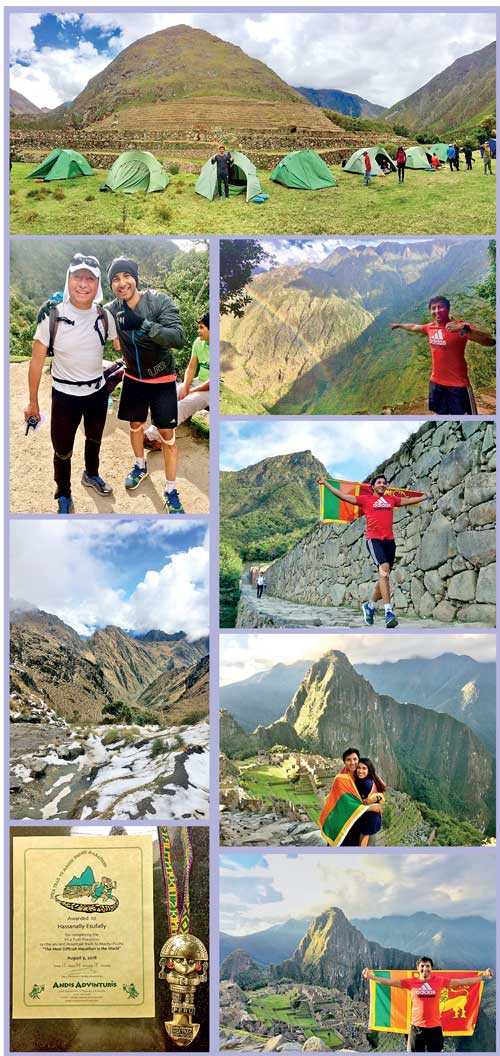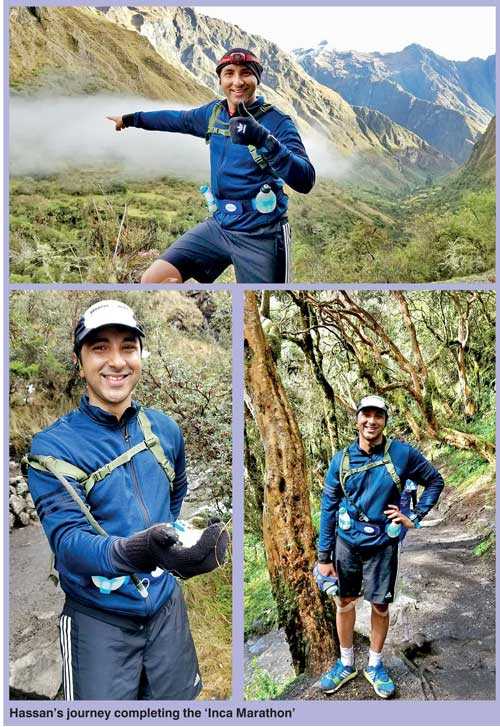Thursday Mar 13, 2025
Thursday Mar 13, 2025
Tuesday, 11 September 2018 00:00 - - {{hitsCtrl.values.hits}}
Leading Sri Lankan marathoner Hassan Esufally, who is on a mission to earn the prestigious 7 Continents Marathon Club Membership, recently ran his first-ever marathon in South America – a gruelling 42km trail across the southern Peruvian Andes. On his challenging journey towards becoming a 7 Continents Marathon Club Member, Hassan has now completed marathons in Europe, Asia, Australia, Africa and South America. Here’s what he had to say about his remarkable experience running the ‘Inca Trail Marathon’ in Peru and becoming the first Sri Lankan to have conquered international marathons in five continents:


Q: Tell us a little bit about your experiences in Cusco – the starting point of the marathon, and how you felt right before you embarked on the 42km run?
A: The day before the marathon, we hiked 13km to Llaqtapata, a beautiful archaeological site located in the Cusco region, where we camped and spent the night. We awoke to a 2 a.m. call and began to prepare for our 4 a.m. kick-off. At this point, I was having a bit of bad luck as I discovered that my hydration pack was leaking. Though this was quite disappointing, as you can imagine, I didn’t let it keep me down for too long – I knew I had to stay in a positive frame of mind to endure the challenges that lay ahead.
With the help of Linda, a trusty fellow runner who gave me a bottle, beanie and waterproof jacket, I was able to change my strategy for carrying fluids throughout the run. I decided to store all of the fluids that I needed in a hand-held bottle encased in a glove and attach it to my running belt. That day, I was reminded for the umpteenth time in my career as a marathoner, that tough situations create tough people.
Q: Take us through the terrain and different stages of the marathon that you ran, and tell us what it’s like up there on the Peruvian Andes?
A: We started the race in total darkness, way before the crack of dawn, with only our headlamps to light the way. This was quite challenging for me given that I’d never run with a headlamp before, but I knew that this was only a foretaste of how much I’d have to push myself beyond my comfort zone during this marathon. In addition to making our way in the rugged and craggy terrain, we were faced with the most extreme and varying weather conditions, ranging from harsh winds and snow to heavy rains and sunshine.
After daybreak, the weather took on a drastic shift from cold and dark to hot and humid, making our hardest uphill section – Dead Woman’s Pass all the more gruelling. Arriving at the lush rainforests of the Amazon basin, we geared up for what we knew would be the toughest section of the entire trail - a 13,800ft climb. During the climb, we experienced a sharp drop in temperatures, with thick layers of snow and ice posing a new challenge to us all. I took a couple of minutes to change my gear and brace myself against the freezing cold weather and with a fresh burst of determination, I prepared myself to withstand the demanding high-altitude conditions.
The entire first half of the marathon was full of varying degrees of uphill and downhill slopes, so I adapted a strategy of walking through the uphill areas and sprinting through the downhill areas as I am a much better downhill runner than an uphill runner. At the halfway mark of the race, I broke away from a fellow runner Melissa and picked up speed in order to make the time cut-off for the Winay Wayna Gate. Passing through the Winay Wayna Gate onto the Sun Gate, we got our first glimpse of the breathtakingly beautiful 15th century Inca site Machu Picchu, which meant that the end for us was in sight as well. At this juncture, I knew that the hardest part of the race was over and I could enjoy the last few miles, really taking in every glorious vista and sound on the hike to Machu Picchu.
Q: What are some of the personal challenges you faced over the course of the marathon, and how did you cope with them?
A: As is the case with all high-altitude terrains, one of the most predictable challenges of this marathon for me was the extremely low air pressure which made breathing very difficult. However, having trained intensely for many months with my high-altitude mask on, I was well-acclimated to withstand the acutely thin air atop the Andes. Moreover, by the halfway point of the marathon, I had twisted my ankles for a grand total of ten times, five times on each leg. By this time, my legs and entire body were so sore, but in spite of it all, I summoned up all the strength and stamina in me to race against time and make the cut-off for the Winay Wayna Gate.
Around an hour before the gate cut-off, my watch died, leaving me to run and track my speed on instinct. I reached the final aid station at Puyupatamarca and left behind all my extra layers of clothing there in order to be as light as possible for what was to be the most taxing stretch yet. The race director had instructed me that those who usually make the gate cut-off get to the final aid station with 1.5 hours left to go – and I just had one. This realisation struck me like a bullet, and with new found energy, I galloped at top speed to make the cut, all while praying to God and recalling memories of my grandfather and high priest to draw inspiration. Despite running on instinct with no way of calculating my pace, and repeatedly twisting and spraining my ankles while running through the treacherous downhill sections, I believed that I would make the cut-off and I did – with just two minutes to spare!
Q: Tell us a little bit about the memorable experiences and encounters that you had along the way?
A: Despite the first half of the trail being quite challenging in its own right, I really enjoyed this part of the marathon thanks to the amazing company of fellow marathoner, Melissa, who ran alongside me through the rough stretches. We took some great pictures of the captivating sights and scenery en route, exchanged food and shared stories all the way, to keep each other going. At the third pass of Runkurakay, where there was a steep uphill ascent, a kind English family lent me a pair of their walking sticks to help with the 12,000ft climb ahead – another experience that I distinctly remember and treasure. It was really encouraging to see how the hikers and holidaymakers on the Inca Trail were very respectful and thoughtful towards the marathon runners, always giving us preference on the course.
My most memorable moments and experiences from the ‘Inca Trail Marathon’, I’d have to say, were when I first entered through the Sun Gate and set eyes on the mighty Machu Picchu fortress – it was profoundly relieving and rewarding to be standing up there, soaking up the beauty and glory of this lost ancient city. On my way to the Sun Gate, I saw a vibrant rainbow beaming ahead, as if to welcome and reward us for all the tireless effort that we had put in to get there. Whilst taking in the scenery, I radioed my wife Rashida to let her know that I was just minutes away from the finish line. I had tears in my eyes when she told me that she had been waiting for me atop Machu Picchu for over four hours by that time. I couldn’t wait to run down the last mile and a half to go and see her.
Q: All in all, what do you have to say about your remarkable achievement in South America and what did it feel like to be out there representing your country?
A: On a personal level, the ‘Inca Trail Marathon’ was more than just a race – it was a one-of-a-kind, life-changing experience. I count myself extremely lucky and blessed to have had the chance to see first-hand and run atop this magnificent citadel. Running past the finish line of what is considered to be the world’s toughest marathon, with the Sri Lankan flag hoisted high above my shoulders is a moment that will forever stay ingrained in my heart and mind. The average person would take three nights and four days to complete a marathon of this nature. To have finished it in just 12.75 hours gave me a profound boost of confidence, and it made me realise that I have truly grown and improved as a professional marathon runner.
Discover Kapruka, the leading online shopping platform in Sri Lanka, where you can conveniently send Gifts and Flowers to your loved ones for any event including Valentine ’s Day. Explore a wide range of popular Shopping Categories on Kapruka, including Toys, Groceries, Electronics, Birthday Cakes, Fruits, Chocolates, Flower Bouquets, Clothing, Watches, Lingerie, Gift Sets and Jewellery. Also if you’re interested in selling with Kapruka, Partner Central by Kapruka is the best solution to start with. Moreover, through Kapruka Global Shop, you can also enjoy the convenience of purchasing products from renowned platforms like Amazon and eBay and have them delivered to Sri Lanka.
Discover Kapruka, the leading online shopping platform in Sri Lanka, where you can conveniently send Gifts and Flowers to your loved ones for any event including Valentine ’s Day. Explore a wide range of popular Shopping Categories on Kapruka, including Toys, Groceries, Electronics, Birthday Cakes, Fruits, Chocolates, Flower Bouquets, Clothing, Watches, Lingerie, Gift Sets and Jewellery. Also if you’re interested in selling with Kapruka, Partner Central by Kapruka is the best solution to start with. Moreover, through Kapruka Global Shop, you can also enjoy the convenience of purchasing products from renowned platforms like Amazon and eBay and have them delivered to Sri Lanka.